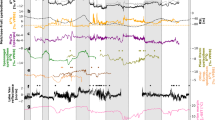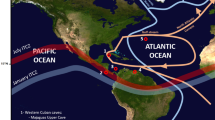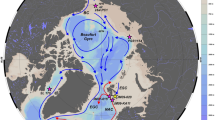Abstract
The last interglacial period (127–110 kyr ago) has been considered to be an analogue to the present interglacial period, the Holocene, which may help us to understand present climate evolution. But whereas Holocene climate has been essentially stable in Europe, variability in climate during the last interglacial period has remained unresolved, because climate reconstructions from ice cores1,2, continental records3,4 and marine sediment cores5,6 give conflicting results for this period7. Here we present a high-resolution multi-proxy lacustrine record of climate change during the last interglacial period, based on oxygen isotopes in diatom silica, diatom assemblages and pollen–climate transfer functions from the Ribains maar in France. Contrary to a previous study8, our data do not show a cold event interrupting the warm interglacial climate. Instead, we find an early temperature maximum with a transition to a colder climate about halfway through the sequence. The end of the interglacial period is clearly marked by an abrupt change in all proxy records. Our study confirms that in southwestern Europe the last interglacial period was a time of climatic stability and is therefore still likely to represent a useful analogue for the present climate.
This is a preview of subscription content, access via your institution
Access options
Subscribe to this journal
Receive 51 print issues and online access
$199.00 per year
only $3.90 per issue
Buy this article
- Purchase on Springer Link
- Instant access to full article PDF
Prices may be subject to local taxes which are calculated during checkout


Similar content being viewed by others
References
GRIP members. Climate instability during the last interglacial period recorded in the GRIP ice core. Nature 364, 203–207 (1993).
Grootes, P. M., Stuiver, M., White, J. W. C., Johnsen, S. & Jouzel, J. Comparison of oxygen isotope records from the GISP2 and GRIP ice cores. Nature 366, 552–554 (1993).
Aalbersberg, G. & Litt, T. Multiproxy climate reconstructions for the Eemian and Early Weichselian. J. Quat. Sci. 13, 367–390 (1998).
Cheddadi, R. et al. Was the climate of the Eemian stable? A quantitative climate reconstruction from seven European pollen records. Palaeogeogr. Palaeoclimatol. Palaeoecol. 143, 73–85 (1998).
McManus, J. F., Oppo, D. W. & Cullen, J. L. A 0.5-million-year record of millennial-scale climate variability in the North Atlantic. Science 283, 971–975 (1999).
Cortijo, E., Labeyrie, L., Elliot, M., Balbon, E. & Tisnerat, N. Rapid climatic variability of the North Atlantic Ocean and global climate: a focus of the IMAGES program. Quat. Sci. Rev. 19, 227–241 (2000).
Kukla, G. J. The last interglacial. Science 287, 987–988 (2000).
Thouveny, N. et al. Climate variations in Europe over past 140 kyr deduced from rock magnetism. Nature 371, 503–506 (1994).
Reille, M. et al. Pollen analytical biostratigraphy of the last five climatic cycles from a long continental sequence from the Velay region (Massif Central, France). J. Quat. Sci. 15, 665–685 (2000).
de Beaulieu, J. L. & Reille, M. Long Pleistocene pollen sequences from the Velay Plateau (Massif Central, France). I. Ribains maar. Vegetat. Hist. Archaeobot. 1, 233–242 (1992).
Kukla, G., McManus, J. F., Rousseau, D.-D. & Chuine, I. How long and how stable was the last interglacial? Quat. Sci. Rev. 16, 605–612 (1997).
Litt, T., Junge, F. W. & Böttger, T. Climate during the Eemian in north-central Europe—a critical review of the palaeobotanical and stable isotope data from central Germany. Vegetat. Hist. Archaeobot. 5, 247–256 (1996).
Juillet-Leclerc, A. & Labeyrie, L. Temperature dependence of the oxygen isotopic fractionation between diatom silica and water. Earth Planet. Sci. Lett. 84, 69–74 (1987).
Shemesh, A., Charles, C. D. & Fairbanks, R. G. Oxygen isotopes in biogenic silica: global changes in ocean temperature and isotopic composition. Science 256, 1434–1436 (1992).
Rozanski, K., Araguás-Araguás, L. & Gonfiantini, R. in Climate Change in Continental Isotopic Records (eds Swart, P. K., Lohmann, K. C., McKenzie, J. & Savin, S.) 1–36 (American Geophysical Union, Washington DC, 1993).
Beyerle, U. et al. Climate and groundwater recharge during the last glaciation in an ice-covered region. Science 282, 731–734 (1998).
Guiot, J., Pons, A., de Beaulieu, J. L. & Reille, M. A 140,000-year continental climate reconstruction from two European pollen records. Nature 338, 309–313 (1989).
Weckström, J., Korhola, A. & B lom, T. The relationship between diatoms and water temperature in thirty subarctic Fennoscandian lakes. Arct. Alp. Res. 29, 75–92 (1997).
Stoermer, E. F. Evaluating diatom succession: some peculiarities of the Great Lakes case. J. Paleolimnol. 8, 71–83 (1993).
Rosqvist, G. C., Rietti-Shati, M. & Shemesh, A. Late glacial to middle Holocene climatic record of lacustrine biogenic silica oxygen isotopes from a Southern Ocean island. Geology 27, 967–970 (1999).
Björck, S. et al. Eemian lake development, hydrology and climate: a multi-stratigraphic study of the Hollerup site in Denmark. Quat. Sci. Rev. 19, 509–536 (2000).
Zagwijn, W. H. An analysis of Eemian climate in western and central Europe. Quat. Sci. Rev. 15, 451–469 (1996).
Frogley, M. R., Tzedakis, P. C. & Heaton, T. H. E. Climate variability in Northwest Greece during the Last Interglacial. Science 285, 1886–1889 (1999).
Fronval, T. & Jansen, E. Rapid changes in ocean circulation and heat flux in the Nordic Seas during the last interglacial period. Nature 383, 806–810 (1996).
Stockhausen, H. & Thouveny, N. Rock-magnetic properties of Eemian maar lake sediments from Massif Central, France: a climatic signature? Earth Planet. Sci. Lett. 173, 299–313 (1999).
Woillard, G. Abrupt end of the last interglacial s.s. in north-east France. Nature 281, 558–562 (1979).
Maberly, S. C. et al. The rise and fall of Asterionella formosa in the South Basin of Windermere: analysis of a 45-year series of data. Freshwat. Biol. 31, 19–34 (1994).
Wolin, J. A. Late Holocene lake-level and lake development signals in Lower Herring Lake, Michigan. J. Paleolimnol. 15, 19–45 (1996).
Battarbee, R. W. & Kneen, M. J. The use of electronically counted microspheres in absolute diatom analysis. Limnol. Oceanogr. 27, 184–188 (1982).
Smol, J. P. The ratio of diatom frustules to chrysophycean statospores: a useful paleolimnological index. Hydrobiologia 123, 199–208 (1985).
Shemesh, A. et al. An oxygen isotope record of lacustrine opal from a European Maar indicates climatic stability during the last interglacial. Geophys. Res. Lett. 28, 2305–2308 (2001).
Acknowledgements
The sediment core was retrieved thanks to the EU project Euromaar. This work was also supported by the TMR scheme operated by the EU, the UK NERC, the Israel Science Foundation and CNRS.
Author information
Authors and Affiliations
Corresponding author
Rights and permissions
About this article
Cite this article
Rioual, P., Andrieu-Ponel, V., Rietti-Shati, M. et al. High-resolution record of climate stability in France during the last interglacial period. Nature 413, 293–296 (2001). https://doi.org/10.1038/35095037
Received:
Accepted:
Issue Date:
DOI: https://doi.org/10.1038/35095037
This article is cited by
-
Innovative method for CO2 fixation and storage
Scientific Reports (2022)
-
The Holocene temperature conundrum answered by mollusk records from East Asia
Nature Communications (2022)
-
Recent advances in isotopes as palaeolimnological proxies
Journal of Paleolimnology (2013)
-
Rick Battarbee and his many contributions to palaeolimnology
Journal of Paleolimnology (2013)
-
Grain-size characteristics and climate variability in TMS5e sequence of Tumen section in southern Tengger Desert, northwestern China
Chinese Geographical Science (2012)
Comments
By submitting a comment you agree to abide by our Terms and Community Guidelines. If you find something abusive or that does not comply with our terms or guidelines please flag it as inappropriate.



